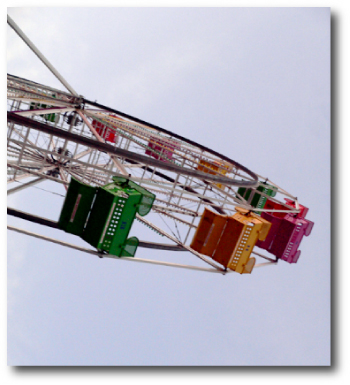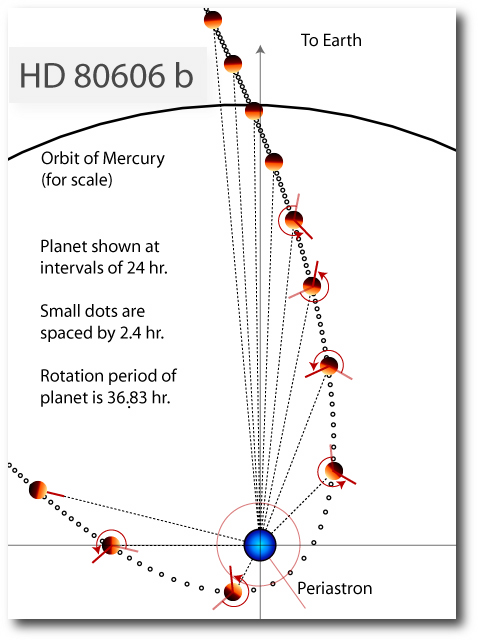
Image Source.
Despite posts here, here, here, here, here, and here, I’m not obsessed with HD 80606b. Really! It’s just that it’s such a bizarre and unique world that I’m convinced that it has the potential to give us a lot of insight into how extrasolar Jovian planets behave.
Consider planetary spin periods. As a consequence of angular momentum conservation, both Jupiter and Saturn spin quite quickly. Their days last 9.92425 hours and 10.65622 hours, respectively. The subnebulae from which they formed were large and slowly rotating, and as the planets contracted, they were compelled to spin up to their current rapid rotation rates.
The hot Jupiters that have been observed so far in the infrared using the Spitzer space telescope are all close enough to their parent stars to have been brought into synchronous rotation. That is, their spin periods are the same as their orbital periods and (assuming that they’re in Cassini state #1) they always present the same hemisphere to the star. The weather on these planets will be strongly influenced by the presence of a permanent day side and a permanent night side.
HD 80606b is different. Tidal forces arising during the periastron passages of its 111.4297 day orbit will have brought it into a state of pseudo-synchronization, in which the spin frequency is ~82% of the instantaneous orbital angular frequency that the planet has as it whips through periastron. More precisely, Piet Hut, in this paper from 1981 shows that,

Plugging in 111.4297 days for HD 80606b’s orbital period and e=0.937 for its eccentricity, we get a spin period of 1.535 days, or 36.8 hours. We’re thus in position to understand how the surface of the planet is exposed to intense stellar irradiation during the periastron passage. From this, as we’ll show in upcoming posts, we can make predictions about what Spitzer will see if it observes the star during the time surounding periastron. The geometry looks like this:

In the above diagram, the sense of the orbit is counterclockwise, and the position of the planet is shown at successive 24-hour intervals. If we were to observe from a fixed longitude on the planetary sphere (shown as the red bar at Noon on the leftmost planetary position) then we spin through 235 degrees worth of rotation every 24 hours. At the end of the first 24-hour period, we’re still on the night-side of the planet. During the second 24-hour period, our spot receives it’s strongest heating, and, because of the orbital motion, the day on the equator lasts considerably longer than the usual 18.4 hours. Our spot then receives more than 24 hours worth of darkness to cool off. It’s on the night-side as the planet makes its closest approach to the star. Shortly before dawn during this 24-hour interval, our own Sun crosses the local meridian, an totally inconspicuous 9th magnitude star shining down onto the turbulent steam-choked atmosphere.

You mention Spitzer here… are there actually plans to observe HD 80606 with Spitzer during the upcoming periastron passage?
Hi Andy,
Drake Deming and I are going to submit a proposal for the next cycle…
I probably sound like a perfectionist… but… Using the formula you posted, I got 1.53596885.
Rounding to three places, you get 1.536, not 1.535. I mean no disrepsect, as I have the highest reverence for your work here.
Excellent site, very uplifting information, beautiful work. Keep it up.
Hi Greg
Do you know of any attempts to “catch” 0606.
I considered it for a second but my wife and family talked me out of it.
Happy New Year
Pingback: systemic - …and then the clouds lifted
Pingback: systemic - HD 118206…
Pingback: systemic - The Perfect Storm
Pingback: systemic - “With all possible expedition”